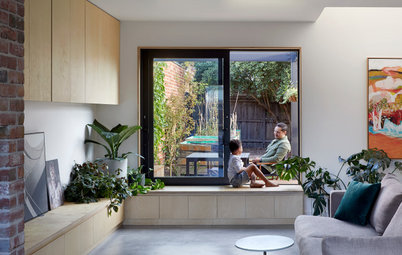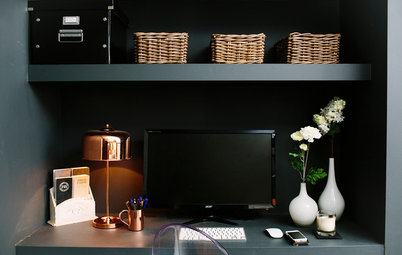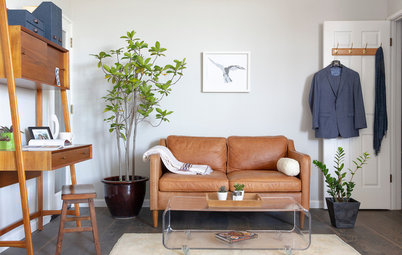8 Ideas for Stylish Media Storage
Not sure how best to house your TV and all its cables, boxes and related bits? Let these solutions spark ideas
Your television and its associated tech may be very well used, but you don’t necessarily want it all to be the main feature in your room. Instead, what your screen sits on – or in – should be the star of the show (when the telly is turned off, at least).
From full-wall, multifunctional units to home office and media wall combos to chic retro style, these Houzz designers have it covered.
From full-wall, multifunctional units to home office and media wall combos to chic retro style, these Houzz designers have it covered.
2. Build in a seating nook
This full wall unit in a central London mews house was created by Ian Dunn Woodwork & Design and includes a low bench seat and a sliding panel to hide the TV when not in use.
The natural wood finish – part solid, part slatted – gives a subtle Japanese feel to the design.
Need help with your living room? Find a local renovation expert in the Houzz Professionals Directory.
This full wall unit in a central London mews house was created by Ian Dunn Woodwork & Design and includes a low bench seat and a sliding panel to hide the TV when not in use.
The natural wood finish – part solid, part slatted – gives a subtle Japanese feel to the design.
Need help with your living room? Find a local renovation expert in the Houzz Professionals Directory.
3. Disguise with paint
Strategic use of colour can work to camouflage your screen. One half of the couple who commissioned Golden Feathers Interiors to design this space really loves watching TV while he cooks, while his wife wasn’t keen on having a screen in the kitchen.
The result is a sleek compromise: when the screen – which sits over a bespoke banquette and between two banks of shelving – is off, it can barely be seen, thanks to the the rich dark blue. The deep colour not only hides the TV, it also ties into the kitchen cabinets and details such as the dining table legs, pulling the whole space together.
More: A Dark Space-wasting New-Build Kitchen is Updated
Strategic use of colour can work to camouflage your screen. One half of the couple who commissioned Golden Feathers Interiors to design this space really loves watching TV while he cooks, while his wife wasn’t keen on having a screen in the kitchen.
The result is a sleek compromise: when the screen – which sits over a bespoke banquette and between two banks of shelving – is off, it can barely be seen, thanks to the the rich dark blue. The deep colour not only hides the TV, it also ties into the kitchen cabinets and details such as the dining table legs, pulling the whole space together.
More: A Dark Space-wasting New-Build Kitchen is Updated
4. Make it a feature
It’s unusual for a TV screen to lead the design of a room, but this scheme by architecture and interior design practice Honky – with the TV screen proudly at its heart – is stunning (and has unsurprisingly won awards).
The television is recessed into a section of luxurious walnut panelling, which conceals any wiring – effectively making a whole-wall media unit – which helps to create a sleek and subtle 1970s theme. It ties in beautifully with the elegant black lamps, fireplace, cushions and coffee table.
The panels are mechanised, so they can slide across and conceal the TV when it’s not in use, but would you even want to?
It’s unusual for a TV screen to lead the design of a room, but this scheme by architecture and interior design practice Honky – with the TV screen proudly at its heart – is stunning (and has unsurprisingly won awards).
The television is recessed into a section of luxurious walnut panelling, which conceals any wiring – effectively making a whole-wall media unit – which helps to create a sleek and subtle 1970s theme. It ties in beautifully with the elegant black lamps, fireplace, cushions and coffee table.
The panels are mechanised, so they can slide across and conceal the TV when it’s not in use, but would you even want to?
5. Combine with a home office
With this multifunctional bespoke media unit, designed by Fitted Lifestyles, a slatted section, a recessed shelf and a change in lighting neatly denote where the TV zone ends and the office begins.
A wooden top spans the full width to form both a desk and a TV area, as well as offering display space. As the top is desk height, this may be taller than the average media unit.
Keeping the top half of the wall empty on the TV side is a nice touch, as the arrangement feels as if it gives this side of the room space to breathe, despite it being very functional.
With this multifunctional bespoke media unit, designed by Fitted Lifestyles, a slatted section, a recessed shelf and a change in lighting neatly denote where the TV zone ends and the office begins.
A wooden top spans the full width to form both a desk and a TV area, as well as offering display space. As the top is desk height, this may be taller than the average media unit.
Keeping the top half of the wall empty on the TV side is a nice touch, as the arrangement feels as if it gives this side of the room space to breathe, despite it being very functional.
6. Favour freestanding
If you prefer a more relaxed look, consider surrounding your TV with a freestanding unit.
Here, Kia Designs has used an off-the-shelf, vintage-style sideboard and flanked it with two tall units in the same style and material to create more of a wraparound look. These offer plenty of storage for all the media equipment, as well as books and ornaments.
The slim legs and open top keep it from feeling too blocky.
See hundreds more examples of media units.
If you prefer a more relaxed look, consider surrounding your TV with a freestanding unit.
Here, Kia Designs has used an off-the-shelf, vintage-style sideboard and flanked it with two tall units in the same style and material to create more of a wraparound look. These offer plenty of storage for all the media equipment, as well as books and ornaments.
The slim legs and open top keep it from feeling too blocky.
See hundreds more examples of media units.
7. Create features that draw the eye
While the bulk of this unit contains closed storage, there are also four open nooks for display. These are made from oak-veneered MDF, which helps them to stand out against the deep blue and draw the eye away from the black screen.
The number of closed door cabinets makes sense when you know the unit – designed by Jenny Luck Interiors and built by MW Creative Carpentry –is in a playroom where toys need to be stashed. Jenny also built in removable drawers, behind which the underfloor heating manifold is hidden.
The TV and associated audio-visual tech also has plenty of space, so wiring and boxes can be concealed, making it a truly multifunctional piece of furniture.
While the bulk of this unit contains closed storage, there are also four open nooks for display. These are made from oak-veneered MDF, which helps them to stand out against the deep blue and draw the eye away from the black screen.
The number of closed door cabinets makes sense when you know the unit – designed by Jenny Luck Interiors and built by MW Creative Carpentry –is in a playroom where toys need to be stashed. Jenny also built in removable drawers, behind which the underfloor heating manifold is hidden.
The TV and associated audio-visual tech also has plenty of space, so wiring and boxes can be concealed, making it a truly multifunctional piece of furniture.
8. Tuck it into an alcove
An all-singing media unit can risk looking out of place in some period properties – or there simply may not be room. In this era-sensitive solution, designer Lisette Voute makes use of the alcoves either side of a chimney breast in a flat in a conservation area.
The doors are perfectly positioned for concealing the wires and boxes associated with the TV, while recessing the screen reduces its visual impact. The alcove bookcases were existing, but Lisette enhanced them. “We added nice moulding and cornicing and new doors,” she says, “so they’d look more elegant and in keeping with the building.”
More: A Dated Flat Regains Period Elegance and Light
Tell us…
Which of these media storage solutions would work well in your home? Let us know in the Comments.
An all-singing media unit can risk looking out of place in some period properties – or there simply may not be room. In this era-sensitive solution, designer Lisette Voute makes use of the alcoves either side of a chimney breast in a flat in a conservation area.
The doors are perfectly positioned for concealing the wires and boxes associated with the TV, while recessing the screen reduces its visual impact. The alcove bookcases were existing, but Lisette enhanced them. “We added nice moulding and cornicing and new doors,” she says, “so they’d look more elegant and in keeping with the building.”
More: A Dated Flat Regains Period Elegance and Light
Tell us…
Which of these media storage solutions would work well in your home? Let us know in the Comments.



















The TV in this living area designed by West & Reid is minimised by being part of a bigger picture full of interest. The packed-in books and ornaments disguise, or rather distract from, the screen.
The TV isn’t hidden, but its impact is cleverly balanced so it feels like a considered element of a bigger scheme.